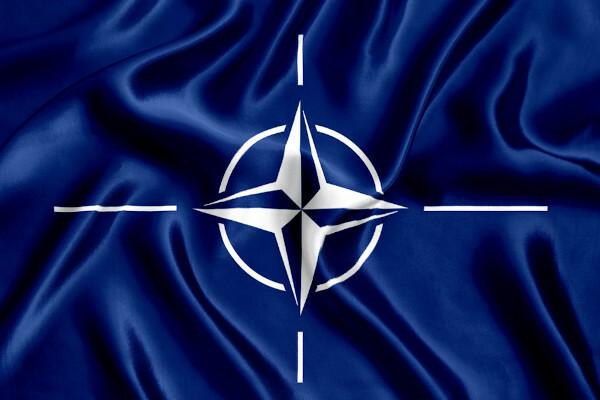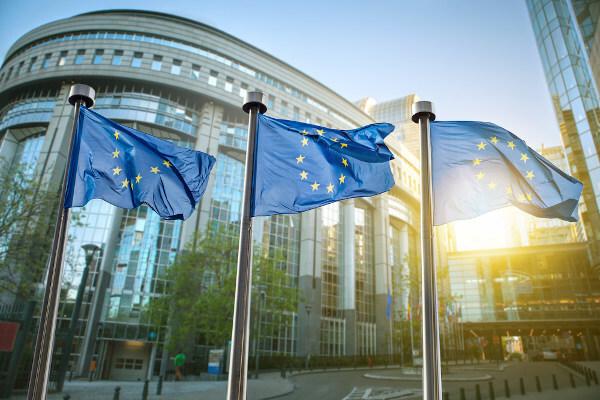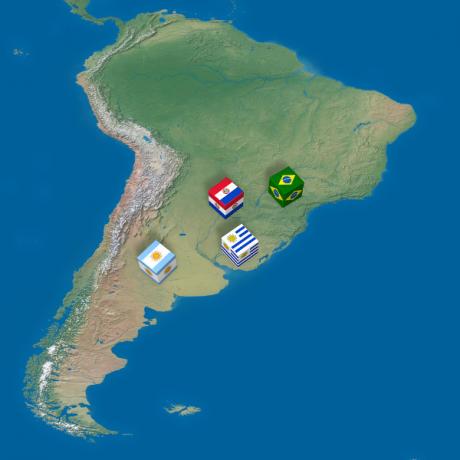THE North Atlantic Treaty Organization (NATO) is an intergovernmental organization formed by 30 countries who help each other politically and militarily.
Created in the context of the Cold War, in 1949, this organization has as one of its pillars ensure the security of its member countries, which can occur diplomatically or with the use of military forces.
It is worth remembering that, in English, NATO's acronym is Nato - North Atlantic Treaty Organization.
Read too: Organization for Economic Cooperation and Development (OECD)
NATO history
NATO was founded in the context of bipolarity of Cold War, in 1949, which involved the United States and Soviet Union in ideological and political conflicts. As a kind of mutual aid between countries bordering the Atlantic Ocean and located in the Northern Hemisphere, NATO emerged after a great world war and the explosion of nationalist movements, one of the causes of Second war.
This help initially involved military and economic matters, in order to contain the expansion of
socialism in Europe Western and increasing capitalist influence in the same locality.As the embryo of NATO, the Brussels Treaty was signed in 1948, starring Belgium, Netherlands, Luxembourg, France and the United Kingdom, among others European countries. The objective of this treaty was the military security of those involved, with the policy of collective security and concomitant assistance.
The following year, in April, the Washington Treaty, which made official the emergence of NATO and the entry of new countries in the following years, such as Canada (1949), Germany (1955) and Spain (1982).
In addition to this military cooperation between the countries involved in the organization, NATO was also created to contribute to European political integration. This is because two Great Wars took place on the continent due to rivalries between governments, and an alliance could prevent a Third War.
Years later, in the 21st century, we realized that this worked, motivating the continent to integrate into the field of economics, such as the consolidation of European Union, in the 1990s.
Do not stop now... There's more after the advertising ;)
military operations
NATO member countries provide part of their military contingent for possible actions of this magnitude, since the organization does not have its own military force. Furthermore, a large part of the operations carried out by NATO take place in the Northern Hemisphere, as in the Afghanistan, Kosovo, North Africa, Middle East, between others.
During the Cold War, NATO did not leave the paper, with administrative meetings and guidelines to be taken by its members, that is, there were no military actions in that period. Yet, after 1990 and the wave of civil wars of that period, the organization entered the scene, as in the invasion of Kuwait by Iraq. Planes were sent to Turkey to secure the country's southeast.
There was NATO intervention in the Bosnian War, with the dissolution of the old Yugoslavia, in 1992.
In addition to having military cooperation among its member countries, NATO also contributes to the United Nations (UN) intervening in areas considered dangerous by the latter organization.
In the 21st century, NATO was involved in missions in Iraq (2004) and Afghanistan (2003), intervened in piracy in the Gulf of Aden and the Indian Ocean, in addition to missions during the Arab Spring, as in Libya, in 2011.

NATO Objectives
NATO emerged in a historical context of the Cold War and intensifying ideological, political and military tensions. Currently, this context no longer exists, however the goals have changed little since its foundation, in 1949.
According to the organization itself, one of NATO's main objectives "is to guarantee the freedom and security of its members by political and military means." As such, we see that NATO exists to protect its members in two ways:
- through political, diplomatic actions in order to prevent conflicts;
- through military actions, which occur when peaceful actions fail and it is necessary to use force, guaranteeing the collective security of those involved.
In the latter case, military actions must be approved by the North Atlantic Council by all member countries (30 countries). These actions can happen in three ways:
- collective defense (when a member country needs help);
- under a UN mandate;
- in partnership with other countries that are not members of NATO, in a corporatist way.
See too: What are NAFTA member countries?
Countries that are part of NATO
Throughout its history of defending the countries of the North Atlantic, NATO has had several allies, and currently 30 countries are members of that organization. They are, in alphabetical order:
- Albania
- Germany
- Belgium
- Bulgaria
- Canada
- Croatia
- Denmark
- Slovakia
- Slovenia
- Spain
- U.S
- Estonia
- France
- Greece
- Netherlands
- Hungary
- Iceland
- Italy
- Latvia
- Lithuania
- Luxembourg
- Macedonia
- Montenegro
- Norway
- Poland
- Portugal
- Czech republic
- Romania
- Turkey
- UK
![NATO Headquarters in Brussels, Belgium. [1]](/f/419ccc99ee6c01020ab5e98fd5a6edc1.jpg)
NATO Structure
The organization works in consensus mode among all 30 member countries. For this, there is a organization chart, with various branches, departments and employees in order to put political and military actions into practice.
At the top of the organization chart are the member countries, who eventually meet to discuss matters related to the organization.

Then we have the Military Representatives and Delegations of NATO. The first is composed of Chiefs of Defense of member countries. When a military mission is delegated, these chiefs provide volunteer military personnel, who go to the mission and return to their respective countries when it ends. This is because NATO does not have a military force of its own.
Already the Delegations are composed of a representative from each member country., which represents his government in any decision-making in the North Atlantic Council. This Council meets once a week or whenever needed. Each member country has a seat on the Council. There is also the Nuclear Planning Group, which monitors nuclear activities across the globe.
The organization is coordinated by the Secretary General of NATO, an international civil servant of the organization who directs the consultation processes as well as the decisions, ensuring that they are carried out. In addition, the secretary is the organization's spokesperson, providing guidance and administrative support to NATO national headquarters and the chairperson of the Council.
Also access: What is the UN Security Council?
NATO and Brazil
In August 2019, the then President of the United States Donald Trump has decreed that the Brazil would be a preferred extra-NATO ally, term used for countries that are not official members of the organization.
This appointment was not the first for a South American country. In 1998, the Argentina it was also designated as a preferred ally.
In practice, this nomination does not mean something great, as preferential allies have no decision-making power in the Council. Experts say this NATO decision is more commercial than political-military, since countries like Brazil can trade military weapons with the United States and vice versa, in addition to preferential access to military studies and technology.
As the Brazilian military strength is inferior to that of the United States (the largest in the world), it is much more likely that Brazil will buy from the United States than the other way around.
Other countries are preferred NATO allies, such as Japan, ColorandI was going south, Tunisia and Kuwait.
NATO today
With different demands than when the organization was created, NATO currently focuses on the nuclear issue., aiming for a world without this type of weaponry, something extremely difficult.
![NATO meeting, 2018, Brussels, Belgium. [1]](/f/053f46d41409a7ae9511c7ae16f667a7.jpg)
There are still on the agenda of the organization desires to increase the number of member countries, which would be beneficial to the globe, since NATO members do not provoke wars among themselves, bringing security and calm. However, when a country applies for membership in the organization, its entry must be unanimously approved by all. This can be a hindrance, as ideological divergences tend to bar the entry of possible new members.
In November 2020, young citizens, aged between 18 and 35, from member countries met with the Secretary General to debate the organization's political and military affairs. This meeting was called NATO2030, and sought to debate the most important issues that may concern NATO in this decade that is beginning.
solved exercises
Question 1 - (FGV 2012) NATO (North Atlantic Treaty Organization) was established in Washington on April 4, 1949. Your creation is listed:
a) The context of approximation of the victorious powers of the Second World War.
b) The process of liberalizing the world economy that would lay the foundations for globalization.
c) The decolonization process in the African and Asian continents.
d) The context of political-military polarization between capitalist and socialist countries.
Resolution
Alternative D. NATO appears in the context of the bipolarity of the Cold War, led by the United States (capitalism) vs. the Soviet Union (socialism).
question 2 – (Puccamp)
“... inspired by humanitarian reasons and the will to defend a certain conception of life threatened by communism, it is also the most effective means of broadening and consolidating influence. in the world, one of the greatest instruments of its expansion (...) has the immediate consequence of consolidating the two blocs and deepening the abyss that separated the communist world and the Western...”
“… the parties agree that an armed attack against one or more of them in Europe or North America must be considered an aggression against them all; and, consequently, they agree that, if such aggression occurs, each of them (...) will assist the party or parties thus attacked...”
The texts identify, respectively,
A) the Monroe Doctrine and the United Nations (UN).
B) the Marshall Plan and the organization of the North Atlantic Treaty (NATO).
C) the Warsaw Pact and the European Economic Community (EEC).
D) the Rio de Janeiro Pact and the Mutual Economic Assistance Council (Comecon).
Resolution
Alternative B. As stated in the second text, aggression against a NATO country is considered aggression against all members. The military security of all members is one of the organization's goals.
Image credit
[1] Alexandros Michailidis / Shutterstock
By Attila Matthias
Geography teacher


